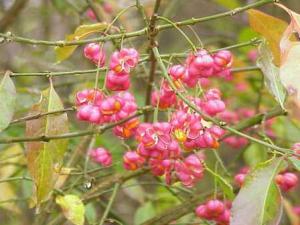Burning Bush

Plants of the Euonymus genus in general are attractive as border shrubs, hedgerows, espaliers, screens, foundation plantings and as single subjects. Named “Wahoo” by American Indians, this plant was once widely used in folk medicine and native American Indian medicine as a stimulant, laxative, emetic, purgative and physic drug. It was also used topically as a poultice for facial sores. The Euonymus genus take its name from the Greek goddess Eurynome, the mother of the Furies ("the Angry Ones"). Known as the Furies in Roman, they were the feared avenging goddesses in Greek and Roman mythology whose job it was to pursue and torment evildoers and sinners. The connection between the plant and the goddess being that the shrub apparently has very irritating and painful properties.
All parts of the plant are toxic and all are dangerously purgative (strongly laxative in effect) and emetic (induces vomiting). Additionally several cardiac glycosides have been found in the seeds of this plant, including evomonoside, a cytotoxic (toxic to cells) cardiac glycoside, whose aglycone is digitoxigenin. Alkaloids make up about 0.1% of the seeds, including evonine. Although the toxicity of the alkaloidal fraction has not been studied it is said that the consumption of as little as four berries can prove fatal for a small child. Currently the plant appears on the Food and Drug Administration's unsafe herb list and is emphatically not recommended for home medicinal use.
Recommended treatment is difficult since the underlying toxin is unknown. In cases where only a small amount of the plant was ingested replace lost fluids and electrolytes, induce vomiting (may further irritate throat and mouth), administer activated charcoal, blood tests to check potassium and magnesium levels, and an electrocardiogram to monitor heart function. Treatment is largely symptomatic and many animals will make a full recovery. In life threatening situations, such as Hyperkalemia, high-degree heart block, cardiac arrest, and ventricular dysrhythmias; Fab framents, a sheep derived digoxin antibody should be given consideration as it has proven to be effective against 'some' plant cardiac glycosides. Prevent Further Ingestion of the Plant and Seek Emergency Veterinary Treatment.




